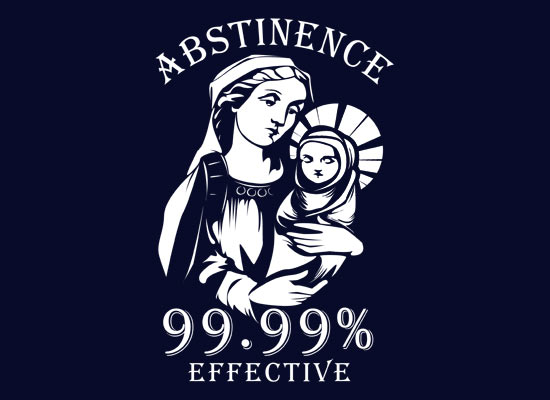
From http://www.snorgtees.com/t-shirts/abstinence-99-99-effective
If you enjoyed this post, please consider donating to Vridar. Thanks!
Musings on biblical studies, politics, religion, ethics, human nature, tidbits from science

This work is licensed under a Creative Commons Attribution 4.0 International License.

From http://www.snorgtees.com/t-shirts/abstinence-99-99-effective
Heh One in 200 Pregnant Women Claim to Be Virgins
http://www.zo.utexas.edu/courses/THOC/VirginBirth.pdf
‘Parthenogenesis in humans may seem far-fetched, but 50 years ago no-one suspected that parthenogenesis could occur in any vertebrate: now all female species have been documented in fish, amphibians, reptiles and birds (all major orders of vertebrates except mammals).
‘In the mid-1950’s, the British medical journal Lancet published an editorial pointing out that it could be difficult to establish suitable criteria for recognition of parthenogenesis in humans.’
Yes, but aren’t the viable offspring female? I have an extremely hard time wrapping my brain around the very idea that a female of any species can give a parthenogenetic birth to a male offspring.
In all cases, parthenogenesis results in exclusively female offspring. Your source acknowledges that: “all female species.” Parthenogenesis creates effectively a clone of the parent, and that parent is always and only female. Thus, there it is simply impossible for parthenogenesis to result in a male offspring, regardless of the species. To claim that the Christian Jesus is the result of parthenogenesis (and thereby defend the “virgin birth” mythology) simply creates far more problems than it solves, which is what typically happens when employing casuistry and apologetics in general rather than logical and rational thought processes.
From the source previously linked:
‘Two different mechanisms exist by which a female could reproduce without contact with a male: (1) budding from somatic cells of the mother or incomplete disjunction during meiosis of gametogenic cells, (2) autofertilization. In the first situation, mother and daughter would be perfect clones, genetically identical (like identical twins). In the second process, the mother would have to produce a sperm which would inseminate her own egg. Mother and daughter would not be genetically identical although the daughter would possess a subset of her mother’s genes, possibly being homozygous at some loci where her mother was heterozygous.’
Both those processes would normally produce females, but it is not strictly true that cloning is the only parthenogenetic mechanism.
A functionally female human chimera might produce male offspring parthenogenetically by either mechanism.
Sorry, the last comment had the wrong link for chimera.
“The Virgin Mary should be given a posthumous medal for getting away with the biggest goddamn lie in the history of humankind.”
——Madalyn Murray O’Hair, founder of American Atheists